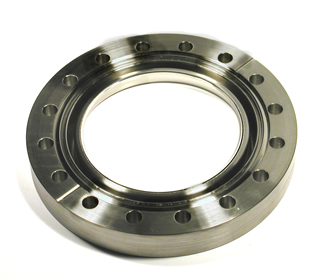In many high vacuum and ultra-high vacuum (HV/UHV) processes it is important to directly observe the procedure in-situ. The challenge therein is that any optical component must penetrate the hermetically-sealed chamber without compromising the vacuum quality. Specialized flanged windows and viewports have been engineered to allow observation of vacuum processes directly or with the assistance of an internal mirror array, without risking the loss of pressure. This mechanical performance is largely dependent on the quality of materials used in the flange and gasket.

Viewport flanges are typically engineered from reliable stainless steel alloys like type 304, while high-purity copper (Cu) is diagnosed as the ideal gasket material in UHV conditions. Yet there are myriad materials available for manufacturing the transparent pane, from standard borosilicate glass to synthetic sapphire.
In this blog post, Allectra explores when and why you might use a sapphire viewport in HV/UHV applications.
Outlining Sapphire Viewports
Sapphire is one of the hardest optical materials utilized in engineering applications. It is a transparent, single-crystal aluminum oxide (Al2O3) with superior thermomechanical properties to virtually every other window material used in HV/UHV processing.
The mechanical properties of sapphire are typified by a compressive strength of approximately 2000 Megapascal (MPa) and a flexural strength upwards of 400 MPa. While sapphire viewports are notoriously hard, they also exploit the material’s excellent Young’s modulus (~350 GPa) to ensure that the pane’s stress-strain ratio is suitable for operation at pressures on an order of trillionths of the atmosphere.
Sapphire viewports are also suitable for high-temperature vacuum processing applications such as physical vapor deposition (PVD). The pane can reliably withstand continuous operating temperatures in the region of 400°C (752°C), although this limit is typically a restraint imposed by the chamber architecture. Sapphire itself can withstand continuous temperatures of up to 1800°C (3272°F).
However, numerous other viewport materials can operate in similarly pressurized and thermal processing applications. The primary benefit of sapphire viewports over other window types is the excellent optical transmissivity of the material. Sapphire viewports are highly transparent to wavelengths of light between 150—5500 nanometres (nm) spanning much of the ultraviolet (UV) and visible spectrum with excellent extension into the near-infrared (IR) range. This ensures optimal viewing of HV/UHV processing conditions without the requirement of additional surface coatings.
The exceptional mechanical properties of sapphire contribute towards this superb transmissivity, as poor surface finish can significantly impact wavelength transmission, particularly for short-wave radiation. Sapphire is the third hardest engineering material on earth, ensuring exceptional resistance to abrasion and scratching. As a result, sapphire viewports retain their as-installed transmission properties for long-service in rugged processing environments.
Sapphire Viewports from Allectra
Allectra specializes in the design and supply of HV/UHV components. Our sapphire viewports are available with diameters of 15 – 49mm, offering both narrow and wide fields of view into thermal processing chambers. Each of our sapphire viewports can also be DUV-rated for the widest transmission range currently available.
If you would like to learn more about our sapphire viewports, please do not hesitate to contact us directly.
